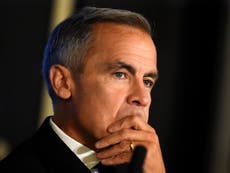Five things that will tell us whether the financial squeeze is really over
While there will be some global downturn in the future, it is not really in sight yet

This autumn we are beginning in the UK, at last, to catch a glimpse of rising living standards and the end of the squeeze on public spending. About time too, you might think. It is 10 years since the collapse of Lehman Brothers and it is eight since the then chancellor, George Osborne, started to rebuild the country’s finances – in other words, a squeeze on public spending.
There is, naturally, a debate about the Lehman crash, and there is naturally a debate about austerity – in both cases, need they have happened, were they handled well or badly, and so on. But let’s leave the past aside and focus on the future: specifically, whether the British economy has made enough progress that it can, irrespective of Brexit, start to increase living standards again.
Here are the things I suggest we should look for over the autumn.
First, public finances. Are they sufficiently solid that the squeeze on public spending can be eased and there not be any need for significantly higher taxes?
There will be a budget coming up, either in November or maybe brought forward to next month, but in advance of this we have the raw material from which the Chancellor will have to fabricate his plans: tax revenue and spending. In the first four months of the fiscal year things looked unexpectedly good: a deficit running well below last year’s £40bn.
This week we get month number five, taxes and spending to the end of August. Big question: has the improvement in public finances been sustained? In particular, is tax revenue still strong? If it has been sustained, it suggests that the economy is still growing because it means people are earning more money (and paying income tax and national insurance contributions on that), and spending it (and paying VAT).
Next, inflation. We also get a batch of numbers on that. In recent months, the rate of increase in pay has at last risen about the consumer price index, so on that measure, working people getting richer. The thing here to look for is whether the CPI is still falling from its earlier highs. It should be, but things such as the rise in the price of fuel may have nudged it up. Sterling has had a bumpy ride and will continue to do so through the rest of the year. The uncertainty over the outcome of the negotiations with Europe will see to that. But it is now clearly undervalued and seems to be climbing a bit.
That leads point number three: will the sterling recovery be sustained? A rising pound improves living standards by holding down import and raw material prices. Of course the sterling rate is determined not only by the attractiveness or otherwise of the pound. It is also a question of what happens to the other currency you are measuring it against. The dollar is currently rather strong (something Donald Trump sounds off about) but it may weaken. To keep it simple, if the pound climbs back above $1.40, then expect a boost from the exchange rate for living standards. If it goes backwards, that will be bad news indeed.
Next, does the job market remain strong? Unemployment is down to 4 per cent, and the intriguing question is whether it can go lower still. It is already the lowest since the 1970s, but it if can, then that is good news for public finances (more tax revenue, less spent on unemployment benefits) but also good news for society as a whole. At least pay rates seem to be rising, which is good news too. Continued solid job growth is a necessary but insufficient condition for feeling that the squeeze is over.
Finally, does global growth continue at its present clip? People focus, inevitably, on what is happening in the town and countryside round about them, but no economy can truly flourish if global growth weakens. It has been battered this year by the threat of a global trade war, or rather, there are fears that it may become battered, for as yet the damage seems to be contained.
There is no simple, single indicator here that tells us what to expect. It would be nice if there were but there isn’t. I rather like to look at the oil price, because demand for oil shows demand for energy, which in turn tells us that the world economy is growing. But there are too many other factors that distort the oil price for it to be more than the vaguest guide. Imports into China are useful too, because that tells us about the world’s second largest economy. I also like German exports, because that says something about demand for high-quality engineering products. But, as I say, there is no single number to look at.
The main point here, though, is that while there will be some global downturn in the future, it is not really in sight yet. While it remains out of sight, living standards in the UK and elsewhere can indeed rise. Governments can indeed raise the taxes they need to in order to provide the services they supply. And I suppose you could say that austerity is indeed over.



Join our commenting forum
Join thought-provoking conversations, follow other Independent readers and see their replies